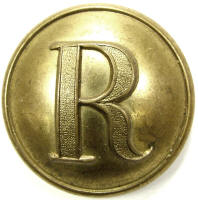
A virtual examination of artifacts of the American Civil War
by Harry Ridgeway
 |
Ridgeway Civil War Research Center, A virtual examination of artifacts of the American Civil War |
| Civil War Artillery | |
by Harry Ridgeway |
| Rifled artillery projectile, Hotchkiss design, Federal manufacture, canister, pattern with thin iron can, iron top, lead balls, lead cup sabot, Ordnance rifle, 3 in. The canister was the artillerist's weapon of last resort. Once the enemy got close to the battery, the gunners would load these rounds, and the flimsy can would burst on firing sending the contents in scatter fashion against the troops charging the cannon. The fire was devastating against the troops but the enemy would be so close that options to reload and shoot would have been limited. The can was constructed of sheet iron shaped into a cylinder, sides are brazed, bottom of the can, also made of sheet, was recessed leaving a lip that was crimped around the sabot. The sabot is cast lead, inscription is also cast with raised letters, "HOTCHKISS 3 in., JAN,Y 7, 1862 " PATENT". The can was filled with balls, usually lead, packed in sawdust, once filled, the can upper lip was then folded around the top plate. Projectile measures: diameter 2.9in., length 8.0in. (excluding fuze), weight 7.1lbs. Research Center: Artillery2522-Canister, Ref: Dickey & George, Field Artillery (1993 Edition), pg. 60. Details click: http://relicman.com/artillery/Artillery2522-Canister.html. |
| Ridgeway Civil War Research Center, A virtual examination of artifacts of the American Civil War. Artillery Research center, artillery, click: http://relicman.com/artillery/Artillery0000-Index.html. Research center, artillery, click: http://relicman.com/artillery/Artillery0000-Index.html. |
| Civil War Relicman, Harry Ridgeway, Civil War artillery, Relicman sales catalog. Click here: http://relicman.com/artillery/RelicmanSalesArtillery1.html. Artillery for sale: http://relicman.com/artillery/RelicmanSalesArtillery1.html. |